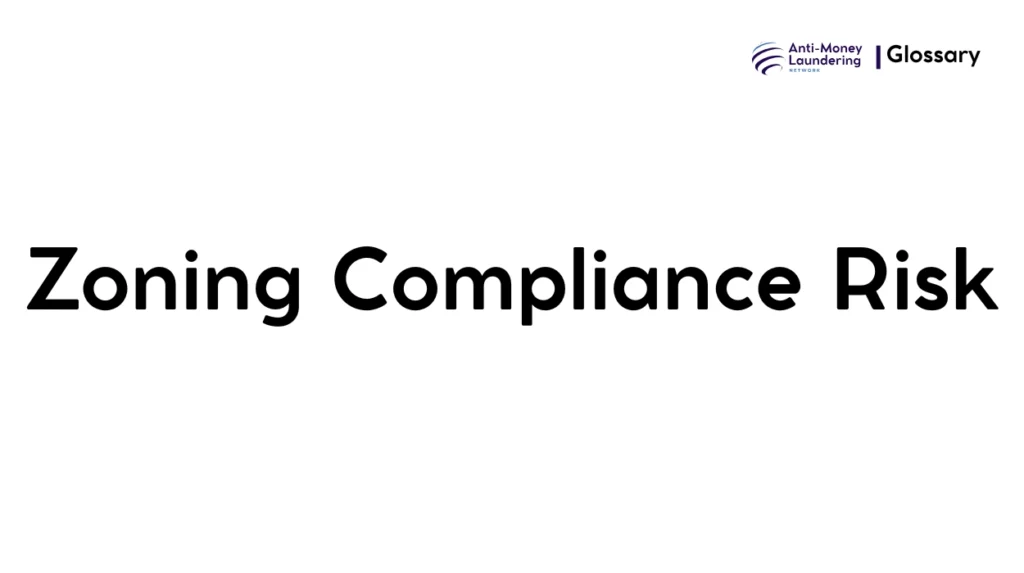Definition
Zoning Compliance Risk in the context of Anti-Money Laundering (AML) refers to the risk that arises when real estate or property transactions do not comply with local zoning laws and land-use regulations, potentially facilitating the laundering of illicit funds. This risk specifically acknowledges that criminals may exploit discrepancies between the declared use and legally permitted use of a property to disguise the origins of illegally obtained money through unauthorized or fraudulent real estate activities.
Purpose and Regulatory Basis
Role in AML
Real estate is a favored vehicle for money laundering due to its high value, complexity, and ability to obscure financial sources. Zoning Compliance Risk plays a crucial role in AML by ensuring every real estate transaction or investment aligns with the prescribed local zoning rules. This helps detect, prevent, and deter illicit financial flows disguised under legitimate real estate dealings.
Why It Matters
Non-compliance with zoning laws can be a significant red flag for AML professionals, triggering enhanced due diligence and suspicious activity investigations. For example, if a residential property is reported but used for commercial purposes, it may suggest efforts to mask illicit transactions.
Key Global and National Regulations
- Financial Action Task Force (FATF): Emphasizes the need for due diligence in real estate transactions to prevent money laundering.
- USA PATRIOT Act: Requires enhanced monitoring of real estate transactions involving financial institutions.
- European Union AML Directives (AMLD): Include transparency and customer due diligence obligations extending to property dealings.
- Local Zoning Laws: National and municipal regulations mandate compliance with land-use policies as part of transaction legitimacy.
When and How it Applies
Real-World Use Cases
- Property purchases and sales: Financial institutions verify zoning compliance before closing deals.
- Mortgage lending: Lenders must confirm property zoning matches stated use.
- Real estate development and investment: Ensuring alignment with zoning prevents laundering via fraudulent projects.
- Commercial leases: Confirming tenant operations comply with zone permissions.
Triggers and Examples
- Properties used for purposes different from their zoning classification.
- Complex corporate ownership structures hiding beneficial owners.
- Large cash transactions for properties in restricted zones such as protected areas.
Types or Variants
Zoning Compliance Risk varies according to the nature of zoning laws and property types:
- Residential vs. Commercial vs. Industrial zoning compliance.
- Mixed-Use Zoning risks requiring layered checks.
- Special Zones like historic or environmental areas necessitating stricter scrutiny.
Procedures and Implementation
Steps for Institutions
- Customer Due Diligence (CDD): Collect zoning-related documents such as permits and certificates.
- Verification: Confirm zoning status with municipal authorities.
- Transaction Monitoring: Use systems to detect mismatches between declared and actual use.
- Enhanced Due Diligence (EDD): Assess high-risk transactions more thoroughly.
- Record Keeping: Maintain detailed evidence for audit trails.
- Suspicious Activity Reporting (SAR): Report possible laundering attempts linked to zoning non-compliance.
Systems and Controls
- Integration of local zoning registries with AML monitoring platforms.
- Training compliance officers to recognize zoning compliance red flags.
- Adoption of geo-spatial mapping and real estate data analytics.
Impact on Customers/Clients
- Customers must provide proof of zoning compliance when involved in property transactions.
- Failure to verify zoning compliance may result in transaction delays or denials.
- Customers face more transparency and disclosure requirements.
Duration, Review, and Resolution
- Continuous and transaction-based zoning compliance assessments.
- Periodic updates on local zoning changes to maintain validity.
- Resolution involves rectifying zoning discrepancies or terminating business relationships if unresolved.
Reporting and Compliance Duties
- Maintain comprehensive records demonstrating zoning compliance diligence.
- Timely filing of reports for suspicious transactions related to zoning issues.
- Cooperation with regulatory audits and investigations.
- Penalties for non-compliance include fines and reputational damage.
Related AML Terms
- Customer Due Diligence (CDD): Verification of client and transaction legitimacy.
- Enhanced Due Diligence (EDD): In-depth checks for high-risk transactions.
- Suspicious Activity Reporting (SAR): Reporting anomalies detected.
- Layering and Integration: Typical money laundering stages involving property.
Challenges and Best Practices
Common Challenges
- Diverse and complex zoning laws across jurisdictions.
- Difficulty accessing current zoning data.
- Verifying actual property use effectively.
- Unraveling sophisticated ownership structures.
Best Practices
- Partner with local zoning authorities.
- Use AML software with zoning modules.
- Provide ongoing training to staff.
- Maintain robust documentation.
- Apply a risk-based approach focusing on high-risk properties.
Recent Developments
- Increased use of AI and big data for cross-verification.
- Emphasis on real estate ownership transparency internationally.
- Adoption of digital land registries.
- Greater global cooperation in zoning compliance.
Summary
Zoning Compliance Risk is a critical component within AML frameworks that helps prevent the use of real estate for laundering illicit funds. By ensuring properties are used according to their legally authorized zoning, financial institutions and regulators strengthen safeguards against money laundering through property transactions, maintaining the integrity of the financial system.

